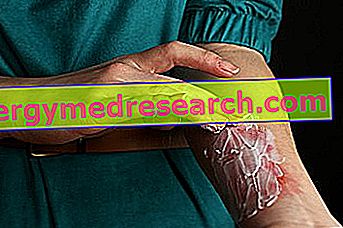Generality
Eicosapentaenoic acid, more simply called EPA, is a semi-essential fatty acid, identified by the acronym 20: 5 (ω-3).
This acronym reminds us how the EPA is formed by a chain of 20 carbon atoms with 5 points of unsaturation (double bonds), the first of which is between the third and fourth carbon atom starting from the terminal omega end (or methyl).
We are therefore talking about a polyunsaturated essential fatty acid, belonging to the omega-three family.

Natural sources of EPA
The ability to synthesize eicosapentaenoic acid is peculiar to microalgae, both of fresh and salt water. This nutrient is then accumulated in the meat of fish that feed on phytoplankton; particularly rich are the fatty fish meats that inhabit cold sea waters, such as cod, salmon, tuna and mackerel, but also herring, sardines and blue fish in general.
Also present in breast milk, the EPA is even more abundant in the oil obtained from these fish, while it is scarce in freshwater fish species.
For vegetarians, an important source of EPA is represented by algae, in particular cyanobacteria (eg spirulina and klamath algae).
Eicosapentaenoic acid is not found in higher plants, although it has been found in traces in purslane or common porcelain, a weed.
In some oily seeds, and in the oil obtained from them, we find instead excellent concentrations of alpha-linolenic acid 18: 3 (ω-3), which - although with some difficulty - can be converted by the human body into acid eicosapentaenoic. This is the case of linseed oil and the seeds from which it is made, hemp oil and canola oil.
The EPA, together with DHA, has been particularly successful in the management of different morbid states, of an inflammatory and pro-oxidant nature.
Indications
Why is EPA used? What is it for?
The main role of the EPA is the anti-inflammatory one: the cascade of enzymatic reactions to which it is subjected in particular circumstances leads to the production of signal-molecules (called "good" eicosanodes) that counteract the pro-inflammatory activity of other similar molecules, originated from the so-called inflammatory cascade of arachidonic acid (AA).
Both of these fatty acids (EPA and AA) are incorporated in the form of phospholipids in the plasma membrane of the cells, that is in that "famous" phospholipid double layer which - distributing itself on the outer surface of the cells - regulates the entry and exit of the various metabolites cellular (nutrients, hormones, waste substances, etc.).
In the presence of tissue damage, enzymes belonging to the class of phospholipases A2 (PLA2) release arachidonic acid from membrane phospholipids, making it the target of other enzymes that originate the so-called "bad" eicosanoids (a bit like LDL cholesterol, the attribute "bad" is however misleading, since these substances, actually essential for health, become harmful only when present in excess).
Eicosanoids influence numerous bodily functions and it is therefore important that they remain in balance with each other thanks to an adequate presence of their precursors.
Now, while arachidonic acid - mostly of carnea origin, but also derived from linoleic acid (18: 2 ω-6) of which olive and seed oils are rich - is abundantly represented in the western diet, alpha linolenic acid and even more eicosapentaenoic acid (EPA), are often deficient due to insufficient consumption of fish or algae.
The resulting chronic pro-inflammatory state could therefore favor the exacerbation of all those diseases in which the inflammatory component is involved in the origin and maintenance of the pathological process (eg rheumatoid arthritis, chronic ulcerative colitis, lupus, inflammatory disease). pelvic, atherosclerosis, etc.).
Not surprisingly, the use of drugs and supplements based on EPA has proved to be potentially useful in the treatment of numerous disorders and diseases, such as:
- Hypertriglyceridemia and hypercholesterolemia;
- Atherosclerosis and ischemic heart disease
- Neurodegenerative disorders;
- Premenstrual syndrome;
- Inflammatory disorders such as inflammatory bowel diseases, systemic lupus erythematosus and rheumatoid arthritis.

Property and Effectiveness
What benefit has DHA shown during the studies?
Numerous, but often over-emphasized, are the experimental evidence supporting the positive effects of EPA - and omega three fatty acids in general - on human health.
From the currently available studies, valuable information would emerge about the real usefulness of this nutrient.
EPA and inflammatory diseases
Adequate use of EPA has been shown to be effective, both in experimental models and in noteworthy clinical trials, in reducing concentrations of inflammatory markers, such as cytokines and leukotrienes.
Considering the pathogenic role of these mediators in the development of diseases such as rheumatoid arthritis, systemic lupus erythematosus and inflammatory bowel diseases, the use of EPA would have very interesting repercussions on the clinical course of these pathologies.
EPA and neurodegenerative diseases
Several authors support the usefulness of EPA supplementation in delaying the progression of neurodegenerative diseases such as Alzheimer's, senile dementia and multiple sclerosis.
The improvement of cognitive, behavioral, relational and motor skills, would derive from the protective action of EPA against nerve membranes subjected to the damaging action of reactive oxygen species
EPA and metabolic pathologies
The metabolic activities of the EPA are well characterized.
In addition to the well-known hypotrigliceridemizing and hypocholesterolemic effect, which is valuable in reducing cardiovascular risk, the adequate use of EPA, would also seem to bring appreciable advantages against carbohydrate metabolism. This effect would be linked to a sensitizing action against the insulin signal
Doses and method of use
How to use the EPA
Dietary eicosapentaenoic acid levels are considered adequate when they are on the order of at least 220 mg a day.
This quota is easily accessible through the consumption of two or three portions of fatty fish per week.

Overall, three grams of EPA and DHA per day (total intake) are generally considered to be safe for health
Side effects
The use of EPA has generally proved to be safe and well tolerated.
However, the appearance of abdominal pain, diarrhea, belching and regurgitations with fishy taste has sometimes been recorded following the intake of EPA extracted from fish liver oil.
At maximum doses, the use of EPA could increase the risk of bleeding, especially in predisposed patients.
Contraindications
When should EPA not be used?
The use of EPA is contraindicated in case of hypersensitivity to the active ingredient or food from which it was extracted.
Pharmacological Interactions
Which drugs or foods can modify the effect of the EPA?
Some noteworthy drug interactions are known between EPA and other active ingredients.
More precisely:
- The simultaneous intake of EPA and aspirin, non-steroidal anti-inflammatory drugs, garlic and ginkgo biloba could increase the risk of bleeding due to a double anti-aggregation effect.
This risk is potentially more serious in the case of concomitant intake of oral anticoagulants (coumadin, sintrom, acenocumarol).
- The concomitant use of EPA and oral hypoglycemic agents could lead to unpredictable changes in glucose metabolism.
In the latter case, given the presence of contradictory studies, it would be very important to evaluate the benefit risk ratio with your doctor.
Precautions for use
What do you need to know before taking the EPA?
The use of EPA during pregnancy, lactation and early life should be supervised by medical personnel.
The same attention should be paid to patients on drug therapy with anticoagulants and antiplatelet agents.
The use of EPA should be suspended before surgery due to the increased risk of bleeding.



